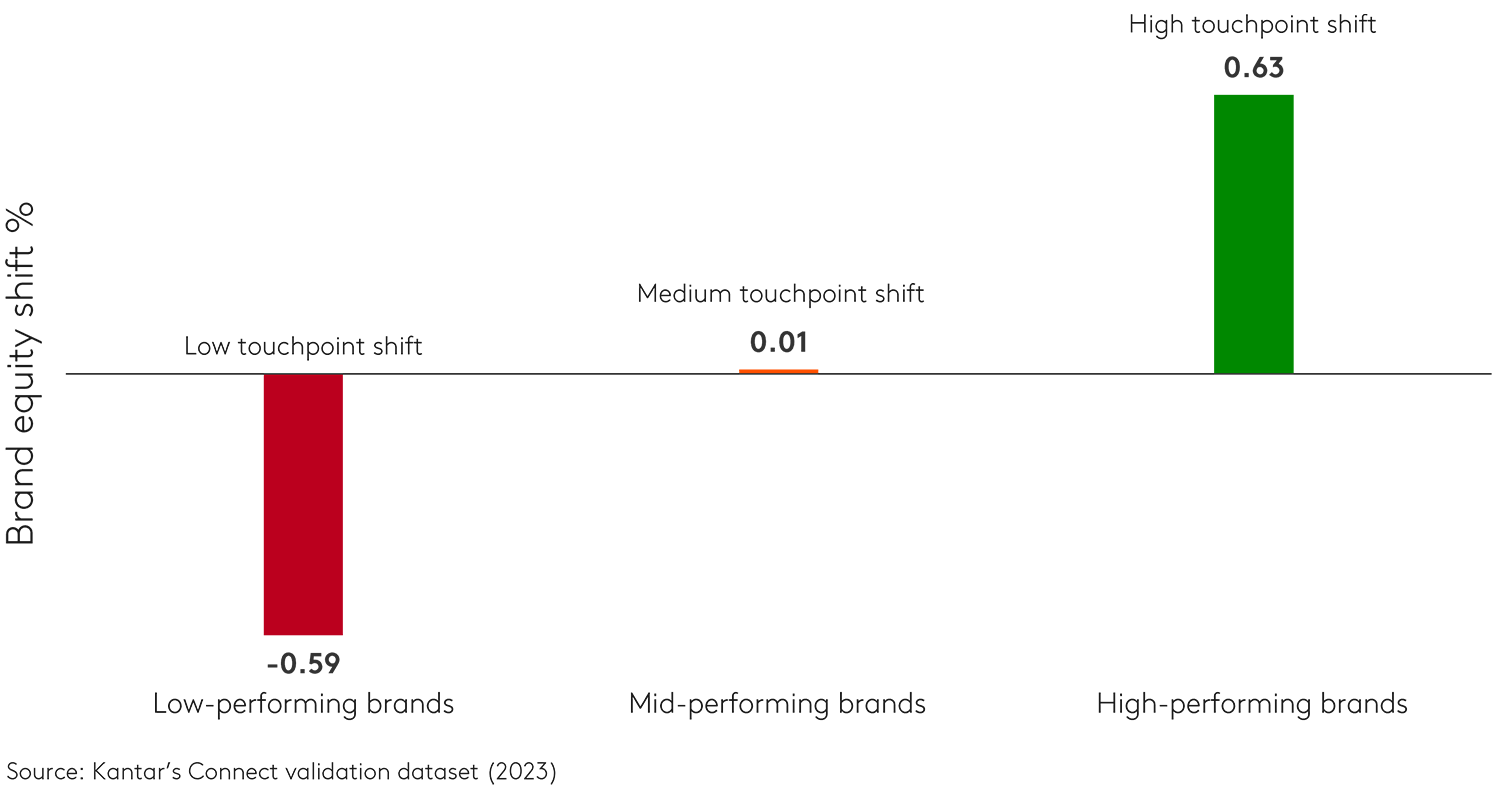Consumers are more accessible today, and yet more distant than ever before. Like exchanging TikToks with your aunt from across the globe, we can communicate through endless media, but how do you know what your aunty is really thinking behind all the cat videos? How can you tell what someone’s attitude towards a brand really is?
With so many points of interaction (touchpoints) a brand can be active on, it’s difficult to connect meaningfully with people, and even harder to know which touchpoints to invest in. Campaigns are almost three times more effective with the right media mix. And when you get touchpoint planning right, it helps to build your brand equity and drive repeat custom through meaningful interactions.
At Kantar, we’ve recently proven that maintaining effective touchpoint management over time leads to increased brand equity, and here’s how.
Brand growth beyond the obvious
A touchpoint is every point of contact a consumer can have with a brand. We can bucket them into three categories:
- Paid touchpoints constitute everything the brand pays for – TV, print, in store, out of home, for example.
- Owned touchpoints are those created and usually controlled by the brand, such as a brand website and product packaging.
- Earned touchpoints are those third-party interactions – word of mouth (friends/family), or a customer review.
For brands to be successful over the long run, they need to understand which touchpoints (paid, owned, earned) are driving the most impact on brand equity so they can optimise investment and improve marketing ROI. Paid media typically only delivers 25% of all touchpoint impact whereas owned and earned touchpoints contribute up to 75%. This emphasises the need to avoid advertising assumptions if your brand is to grow – look beyond the obvious and uncover the blind spots.
Our database shows that on average, a magic 20% of touchpoints deliver most of the brand impact. Our touchpoint optimisation solution, Connect, helps marketers understand the impact of recent touchpoint experiences and identify the touchpoints that drive growth for their business.
The impact of touchpoint experiences on brand equity
How consumers think and feel about a brand depends to a great extent on experiences and associations collected over many years – an iconic TV ad seen as a child, for example, remembering parents buying the brand, or own product experiences formed years ago. But there are many more opportunities to influence consumers’ attitudes with impactful advertising and other touchpoint interactions, whether you are a new or well-established brand.
And why is this important? Recent touchpoint experiences have become more and more relevant to the way people think and feel about a brand. Our data shows an increase in the contribution of recent touchpoint experiences on brand equity, growing from 15% in 2018 to 20% in 2022.
At Kantar, we measure the impact of recent touchpoint experience by looking at the quality as well as the reach of a consumer’s recent interactions with a brand – how memorable was the touchpoint in the consumer’s mind? What was the quality of their experience with this touchpoint? Insights from these questions allow us to determine how much of a consumers’ attitude towards a brand is formed by these newer experiences.
We investigated the relationship between recent touchpoint experiences (touchpoint impact) and brand equity over time to see what this meant for touchpoint planning and brand growth.
Increase touchpoint impact to grow brand equity
We analysed 349 brands with a robust dataset spanning 42 touchpoint planning studies across several industries from 2017 onwards. We found that a higher touchpoint impact between studies leads to increased brand equity, while brands with a lower touchpoint impact over time tend to see equity fall.
Strong touchpoint impact over time builds brand equity

High-performing brands increased touchpoint impact the most between studies – they saw a more marked ‘touchpoint shift’.
Brands that increased their touchpoint impact the most between studies increase brand equity by 0.63% on average. Brands in the middle, however, that experienced little to no change in touchpoint impact, saw no real shift; this emphasises the importance of positive touchpoint experiences and impact to see any real change in equity.
Tellingly, just as a small increase in touchpoint impact can influence brand growth, even a small decline in touchpoint impact over time negatively impacts brand equity. The lowest-performing brands – those that decreased touchpoint impact between studies saw a decline in brand equity of 0.59% on average.
Predicting brand growth
Tracking changes in brand equity emphasises the importance of measuring touchpoint strength over time and helps to identify trends. Our analysis clearly shows that higher touchpoint impact over time leads to increased brand equity. If a brand can increase the reach and quality of its targeted touchpoints, then it is more likely to grow.
This effect is even more significant for big brands. While just a small increase in touchpoint impact over time powered brand equity for small brands, big brands needed more than double the touchpoint impact to achieve a similar increase in brand equity.
Irrespective of brand size, any touchpoint strategy should include a holistic mix of paid, owned, and earned touchpoints. One successful airline brand found that their top ten most impactful touchpoints were spread across all three channel types. It was only through commissioning repeat studies, however, that they were able to identify the importance of their paid and earned digital media channels – leading to a clear increase in impact and relevance for these touchpoints across studies. The result was a focused touchpoint plan which maximised high-performing media to continue to drive impact and grow brand equity.
Eat. Sleep. Touchpoint plan. Repeat.
Brand strength relies on optimised touchpoint planning. Brands need to continually evaluate their strategy to ensure the right touchpoints are targeted to drive positive consumer experiences and ultimately, brand growth. Get in touch to find out how you can identify your magic touchpoint mix to unleash the power of your brand.


